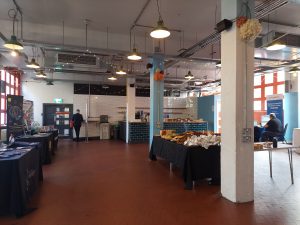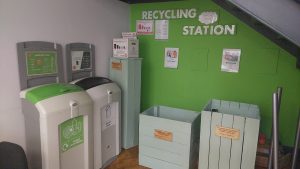11 July 2024
It can be problematic to perfectly blend social, environmental and financial goals when organising an academic event, but we think that Chrissy Hammond (University of Bristol) and her co-organisers Lizzie Lawrence, Joanna Moss, Nikki Stevenson and Rabia Sevil rose to the challenge at The Dynamic matrix: mechanics, ageing and repair Conference, a British Society for Matrix Biology (BSMB) meeting. We were delighted to support this event from our Fund for Innovations in Sustainable Conferencing and Scientific Meeting Grants, and we are keen to continue supporting events like this in the future.
 We are very grateful to Chrissy for welcoming us at this event. We had the opportunity to talk with the main stakeholders involved in the planning process and we would like to share with you some of the good practices they implemented whilst organising a green meeting.
We are very grateful to Chrissy for welcoming us at this event. We had the opportunity to talk with the main stakeholders involved in the planning process and we would like to share with you some of the good practices they implemented whilst organising a green meeting.
This BSMB meeting created a unique opportunity for people at different stages in their careers to network and learn about the latest innovations in matrix biology. Organising the poster session in the relaxing atmosphere of a welcoming venue or arranging for delegates to walk together to the dinner venue were just a couple of the things that the organisers considered to increase early-career researchers’ engagement.
Chrissy was very driven by the idea of creating equal opportunities for everyone, contributing to the social side of sustainability. For this reason, working together with charities was at the heart of her sustainability strategy.
“[When organising an event], you can choose to spend the money at a standard venue or spend it in places where the money will trickle down a lot further.”
Chrissy Hammond
Chrissy’s choices had an impact that extended beyond this event, aiming to make a difference at a higher level, as Mark Coates, the CEO of Creative Youth Network (the event’s venue), explained:
“Choosing a venue operated by a charity or community group adds real social value compared with hiring a more ‘mainstream’ space. Here at Creative Youth Network, we’re doing all we can to raise money towards our charitable mission of supporting young people. Public funding for youth services is less than a quarter of what it was 15 years ago, so for us the income we can generate from our buildings has never been more vital. Every surplus pound we make from this activity goes towards either further investment in our facilities, including the upgrades we need to make as part of our journey towards carbon net zero, or vital charitable services for some of our area’s most vulnerable and under-served young people. Chrissy and her team’s choice to host this conference at the Station has therefore had wider social impact as well as contributing to our sustainability in both financial and environmental terms.”
 Within the budget she was working with, Chrissy and her co-organisers managed to collaborate with many charities such as the Creative Youth Network that support social causes, whilst also implementing many actions that support environmental goals. A lot of the event’s carbon footprint depends on the venue’s own strategy to reduce its emissions. The organisers managed to find an excellent venue for this conference, which uses 100% renewable electricity. Event waste management is definitely not just one person’s job, and the venue helped with recycling almost everything in-house. By joining forces with the venue, the organisers managed to reduce the waste considerably by implementing small but impactful actions: reusing badge holders from previous events, requesting reusable cutlery from the caterers, and ensuring that leftover food was redistributed to the social youth groups that run on the site.
Within the budget she was working with, Chrissy and her co-organisers managed to collaborate with many charities such as the Creative Youth Network that support social causes, whilst also implementing many actions that support environmental goals. A lot of the event’s carbon footprint depends on the venue’s own strategy to reduce its emissions. The organisers managed to find an excellent venue for this conference, which uses 100% renewable electricity. Event waste management is definitely not just one person’s job, and the venue helped with recycling almost everything in-house. By joining forces with the venue, the organisers managed to reduce the waste considerably by implementing small but impactful actions: reusing badge holders from previous events, requesting reusable cutlery from the caterers, and ensuring that leftover food was redistributed to the social youth groups that run on the site.
The reduced waste was also noticed by participants:
“There is simply a lot less waste. For example, regarding cups for coffee and water, it is a lot easier to have your own, and then it reduces a lot of the cutlery. […] Primarily, when I attend a conference, there is so much waste, and a lot of paper and plastic are used […]. But the way they did it here, it is better for sustainability and convenience for everybody.”
Marc Farcasanu, PhD student at Newcastle University
All these actions were on top of the caterer’s strategy to decrease their waste:
“Everything can be reused. Leftover food can be given to families in Bristol, other things can be frozen and turned into something else later, and what cannot be recycled can be composted.”
Barny Haughton MBE, chef, CEO and founder of the Square Food Foundation, one of the event’s main catering suppliers
 We were also pleasantly surprised by the food at this event. It was delicious (just check out the picture!), sustainably cooked and responsibly sourced. Climate change affects the availability of food all around the world. International events can play an important role to help, as Barny highlighted:
We were also pleasantly surprised by the food at this event. It was delicious (just check out the picture!), sustainably cooked and responsibly sourced. Climate change affects the availability of food all around the world. International events can play an important role to help, as Barny highlighted:
“All roads lead to food. Poverty, climate change, social justice, everything is linked in the end to food. It is a big challenge, and it is critical to have more social engagement about the food system. […] Conferences are all about connecting people, and here we can spread knowledge more organically.”
 Food is perhaps one of the most complex aspects of event organising. Barny gave us a good insight into what it means to be a sustainable event caterer:
Food is perhaps one of the most complex aspects of event organising. Barny gave us a good insight into what it means to be a sustainable event caterer:
“When I am building up a sustainable menu, I immediately think of good taste, environmental cleanliness, and fairness for the farmer and for the cook. This concept is often referred to as slow food. I also prioritise seasonal, local, and organic ingredients. A simple model to cover these aspects is buying your ingredients from a farmer’s hub where you have local, small producers whose ingredients have a clear provenance.”
Making the effort to provide environmentally friendly and socially responsible food at your event will pay off. Unfortunately, when facing climate change, we also need to learn to be comfortable with uncertainty, as Barny explained:
“When I design a menu, I tend to change my mind a lot. We need to be flexible since climate change affects the availability of our ingredients. Global warming brings more droughts and floods, and therefore, we have less reliable sources of ingredients compared with the past. These are real issues that we need to address when building a sustainable menu. I think a great way to start is by simply having a conversation about these matters with your sustainable caterers and trusting them with this process.”
Another complex aspect of this meeting that has a high environmental impact is transportation and the organisers put a lot of effort into minimising its carbon footprint. For instance, one of the main criteria for venue selection was to be easily accessible by public transport and within walking distance of the dinner venue and train station. Another action taken to reduce the transportation’s carbon footprint was the planning of the event in a hybrid format.
“Everybody can agree that in-person is much nicer […], but remote options have their advantages too. One of them is counting down air miles from international participants. The other one is offering accessibility for people with disabilities. I am keen not to go back to something exclusively in-person that can exclude people. […] If we get some of the big names to have their talks remotely, we are normalising the online experience and people will feel less afraid that they will be missing out if they cannot join in person.”
Chrissy Hammond
Hybrid is a great option, but there are other aspects to consider as an event organiser:
“It is powerful to allow people to attend remotely, and I think that there need to be further developments that will make this smoother. […] One of the shortcomings of remote attendance is that even though you can present and take questions from the audience, […] you cannot replicate all those interpersonal interactions. The technology needs to continue developing to make that possible.”
Joe Swift, University of Manchester
 Engaging the participants in minimising the event’s carbon footprint will also amplify your positive impact. As Chrissy said, “we want to pass this on and inspire people in the room so that when it is their turn to organise a conference, they might also take sustainability into account.”
Engaging the participants in minimising the event’s carbon footprint will also amplify your positive impact. As Chrissy said, “we want to pass this on and inspire people in the room so that when it is their turn to organise a conference, they might also take sustainability into account.”
Conclusions
The best approach an organiser can take while planning their sustainable event is to collaborate as much as possible with suppliers who can further minimise the environmental impact of the meeting. Maximising the benefits of a hybrid format, while planning strategically in advance is necessary to ensure that the event will run smoothly. As Chrissy suggested, reach out early to those who have already organised similar events and ask for their advice. The Company of Biologists are happy to offer support at sustainability@biologists.com and with grants from our Fund for Innovations in Sustainable Conferencing.









You must be logged in to post a comment.